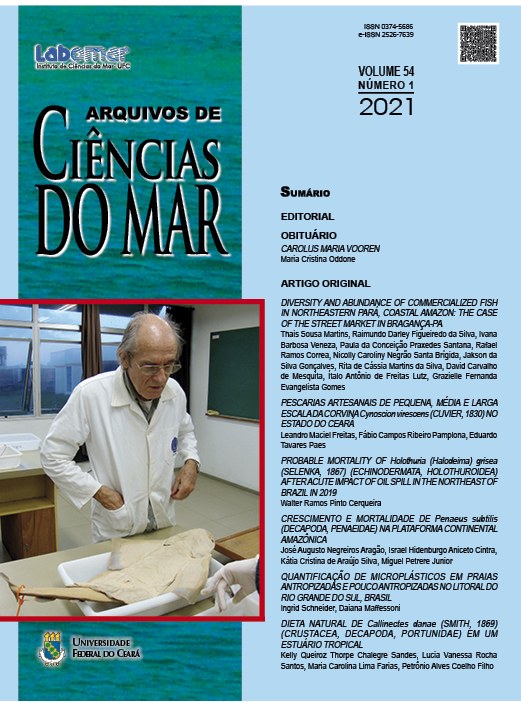PROBABLE MORTALITY OF Holothuria (Halodeima) grisea (SELENKA, 1867) (ECHINODERMATA, HOLOTHUROIDEA) AFTER ACUTE IMPACT OF OIL SPILL IN THE NORTHEAST OF BRAZIL IN 2019
Provável mortalidade de Holothuria (Halodeima) grisea (Selenka,1867) (Echinodermata, Holothuroidea) após impacto agudo do derramamento de petróleo no Nordeste brasileiro em 2019
DOI:
https://doi.org/10.32360/acmar.v54i1.43608Abstract
The Brazilian northeastern coast suffered in 2019 the greatest acute impact of oil in the country’s history, with all states in the region being affected by extra-heavy oil. Holothuria (Halodeima) grisea is a detritivorous holoturoid, which ingests sediment to feed, and can passively ingest oil from spills existing in the sediment. To investigate the occurrence of oil in the intestinal content of H. (H.) grisea, a N of 20 individuals was collected on the Salvador coast (BA) in October 2019 between the coordinates 12°57 ‘S / 38°20’ W. Of this total, 10 individuals were found dead in the environment and 10 collected alive, for comparison purposes. Of the individuals found dead, 40% were eviscerated (without intestines) and it was not possible to carry out content analysis. Of the 6 remaining dead individuals, 67% had oil in their intestinal contents. For the 10 live sea cucumbers collected, none was eviscerated and all had a full intestine, with oil being observed in the intestinal content of 1 specimen (10%). The χ2 test confirmed with α of 0.025 the possible relationship between oil and the mortality of H. (H.) grisea, demonstrating that the acute oil spill probably was lethal for this species on the northeastern coast of Brazil.
Keywords: sea cucumber, hydrocarbons, PAHs.
Downloads
Published
Issue
Section
License
1. Proposta de Política para Periódicos de Acesso Livre
Autores que publicam nesta revista concordam com os seguintes termos:
- Autores mantém os direitos autorais e concedem à revista o direito de primeira publicação, com o trabalho simultaneamente licenciado sob a Licença Creative Commons Attribution que permite o compartilhamento do trabalho com reconhecimento da autoria e publicação inicial nesta revista.
- Autores têm autorização para assumir contratos adicionais separadamente, para distribuição não-exclusiva da versão do trabalho publicada nesta revista (ex.: publicar em repositório institucional ou como capítulo de livro), com reconhecimento de autoria e publicação inicial nesta revista.
- Autores têm permissão e são estimulados a publicar e distribuir seu trabalho online (ex.: em repositórios institucionais ou na sua página pessoal) a qualquer ponto antes ou durante o processo editorial, já que isso pode gerar alterações produtivas, bem como aumentar o impacto e a citação do trabalho publicado (Veja O Efeito do Acesso Livre).

